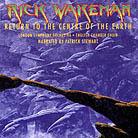May 1999
This opus joins Wakeman with the London Symphony Orchestra and the English Chamber Choir plus six guest vocalists: Ozzy Osbourne, Bonnie Tyler ("Total Eclipse of the Heart" fame), Tony Mitchell (new artist), Trevor Rabin (ex-Yes), Justin Hayward (Moody Blues), and Katrina Leskanich (Katrina and the Waves). Like the original recording, Return is narrated, this time by Patrick Stewart. But what you have here is not a retread of the 1974 original. All the music is new, and the story line is also new. This time we have three unnamed explorers duplicating the original descent into the earth 200 years after the original. They take a different path and have different adventures. Return is a long disc -- over 76 minutes. Narration accounts for about 20 minutes of the total, but each narrative interlude is a separate track, which makes it easy to skip over if you don't want to hear it. I like the music a lot. It is a great combination of symphony, choir and rock, a spectacle of epic proportions, as they say. But if you have little tolerance for melodic/symphonic Yes tracks, Wakeman’s solo efforts like "The 6 Wives of Henry the VIII," "No Earthly Connection," the original Journey to the Centre of the Earth, early Moody Blues, and other examples of the symphonic/progressive rock genre, you won’t be drawn in by Return. This release is for people who remember the original fondly and who are looking for something similar but still new. Return is not an effort on Wakeman’s part to
become a classical The quality of the recorded sound is the Achilles heel, however. In two-channel stereo, the sound is thick, muddy and lacking dynamics with really poor bass quality in the orchestra and choir tracks. Tympani become wimpani. Detail is lost in the fog. The choir is a homogenized sound more like a mellotron than that of a live choir. The orchestral sound is thin, flat and completely lacking depth. There is nothing vaguely resembling transparency. Patrick Stewart’s narration was very well-captured except for one problem: the microphone. There is so much sibilance and so many whistles that it gets annoying to listen to Stewart talk for long. I’ve heard his voice live without amplification, and it doesn’t have any of the whistles and sibilance you hear on this recording. Things get much better when you feed this Dolby Surround-encoded disc though a Dolby ProLogic decoder, so much better that it becomes listenable and enjoyable. It's still flawed, but not fatally flawed. I didn’t spend a lot of time trying to figure out why it sounds so much more acceptable through a ProLogic decoder, but just about everything improves. Experiment with turning the center speaker on and by using the phantom and normal center-channel options for two different presentations -- I couldn’t decide which one I preferred. All this recording needed to be a real watershed release was a producer-and-recording-engineer team that could translate Wakeman’s vision into sonic splendor. Alan Parsons could have elevated this project to sublimity. Wakeman is credited with producing Return, and apparently he was enamored of the convenience of being able to record anywhere (digitally) and combine tracks easily later. Unfortunately, this approach seems to have been undertaken with no attention paid to preserving fidelity. Darn! So close, yet so far. Message to EMI Classics and Rick Wakeman: please do something like this again, but get some help to keep the sound quality high. GO BACK TO: |
 Rick Wakeman - Return to
the Centre of the Earth
Rick Wakeman - Return to
the Centre of the Earth![[Reviewed on CD]](../format/regcd.gif) It was
25 years ago (April 20,1974 to be exact) that Rick Wakeman taught the band to play Journey
to the Centre of the Earth, and he sold 12 million of the darn things. So what is the
ex-Strawbs, ex-Yes, and solo keyboardist up to with Return to the Centre of the Earth?
Proving that you can go back home -- and make money doing it. But what the heck is
EMI Classics doing releasing a Rick Wakeman extravaganza? I don’t know for sure, but
I suspect the company's 1997 release of Paul McCartney’s Standing Stone
probably sold more copies that the rest of their entire catalog in its first 12 months.
Whenever you can score like that, a return trip is definitely justified. Paul McCartney
didn’t have another symphonic work in his back pocket, but Rick Wakeman did. A deal
was struck and Wakeman set off to spend over a year finishing the project.
It was
25 years ago (April 20,1974 to be exact) that Rick Wakeman taught the band to play Journey
to the Centre of the Earth, and he sold 12 million of the darn things. So what is the
ex-Strawbs, ex-Yes, and solo keyboardist up to with Return to the Centre of the Earth?
Proving that you can go back home -- and make money doing it. But what the heck is
EMI Classics doing releasing a Rick Wakeman extravaganza? I don’t know for sure, but
I suspect the company's 1997 release of Paul McCartney’s Standing Stone
probably sold more copies that the rest of their entire catalog in its first 12 months.
Whenever you can score like that, a return trip is definitely justified. Paul McCartney
didn’t have another symphonic work in his back pocket, but Rick Wakeman did. A deal
was struck and Wakeman set off to spend over a year finishing the project.